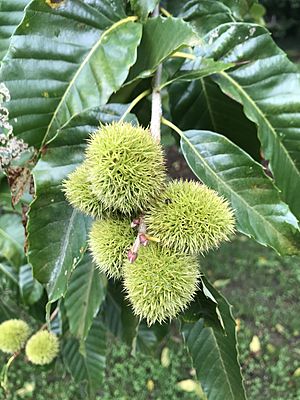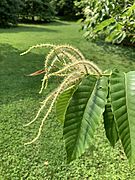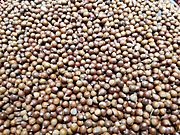Castanea henryi facts for kids
Quick facts for kids Castanea henryi |
|
|---|---|
 |
|
| In fruit | |
 |
|
| Castanea henryi botanical illustration | |
| Scientific classification | |
| Genus: |
Castanea
|
| Species: |
henryi
|
| Synonyms | |
|
|
The Henry chestnut, also known as Henry's chestnut, Chinese chinquapin, or pearl chestnut, is a special type of chestnut tree. Its scientific name is Castanea henryi. This tree grows naturally in south-central and southeast China. It can grow very tall, reaching up to 30 meters (about 100 feet)!
What is the Henry Chestnut?
The Henry chestnut is a large tree that belongs to the chestnut family. It's known for its strong wood and its nuts. Even though the tree itself is very big, its nuts are usually smaller than you might expect.
Where Does it Grow?
This tree is native to China. This means it grows there naturally and has been part of the environment for a very long time. It thrives in the warmer, wetter parts of south-central and southeast China.
Why is it Important?
The Henry chestnut is important for a few reasons:
- Timber: Its wood is very strong and good for building things. People use it as a source of valuable timber.
- Nuts: While the nuts are small, they are still eaten.
- Cultivation: Like its close relative, the Chinese chestnut (Castanea mollissima), the Henry chestnut is widely grown in China. Farmers have developed many different types, or varieties, of this tree over the years. This helps them grow trees that are even better for wood or nuts.
See also
 In Spanish: Castaño de Henry para niños
In Spanish: Castaño de Henry para niños



